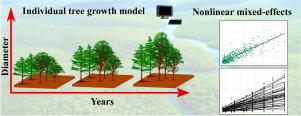Ecological Modelling ( IF 2.6 ) Pub Date : 2021-08-02 , DOI: 10.1016/j.ecolmodel.2021.109683 Sandra Aguiar de Oliveira Pires 1 , Adriano Ribeiro de Mendonça 1 , Gilson Fernandes da Silva 1 , Marcus Vinícius Neves d'Oliveira 2 , Luís Claudio de Oliveira 2 , Jeferson Pereira Martins Silva 1 , Evandro Ferreira da Silva 3

|
In forests of the Amazon biome, Sustainable Forest Management Plans are based on technical guidelines. Such legislation provides for a cutting cycle that can vary from 25 to 35 years and a minimum cutting diameter of 50 cm. In view of the above, the present research aimed to evaluate the accuracy of regression models for the projection of growth in diameter and to calculate the t by diametric class for trees of the species C. guianensis and T. altíssima. Four models with fixed effects were tested and best model was selected as the base model for the incorporation of random effects. The best fixed-effect model was Pienaar and Schiver. Thus, structures of variance and autocorrelation were added to this model to correct heteroscedasticity and autocorrelation. Finally, the time of passage for each species studied was calculated. The average annual increment in diameter estimated with the Pienaar and Schiver model with fixed effect was 0.38 cm.year−1 for C. guianensis and 0.46 cm.year−1 for T. altissima. Using the Pienaar and Schiver model with a random effect, the average annual diameter increase varied from 0.31 to 0.58 cm.year−1 for C. guianensis and from 0.37 to 0.65 mm.year−1 for T. altissima. Results showed that the estimated cutting cycle varied from 24 to 45 years for the species C. guianensis and from 21 to 38 years for the species T. altissima. Thus, using the cutting time of 25 to 35 years and a minimum cutting diameter of 50 cm for these species, can lead to incorrect decisions about the intensity of logging or the appropriate length of the cutting cycle. The growth and production models depict a synthesis of the growth dynamics of the forest, allowing to providing fundamental information for the definition of planning strategies, such as the establishment of a cutting cycle and an exploration intensity more compatible with the growth rate of the forest and for each species.
中文翻译:

Carapa guianensis 和 Tetragastris altissima 的生长模型,以改善亚马逊原始森林的管理
在亚马逊生物群落的森林中,可持续森林管理计划基于技术指南。此类立法规定的切割周期可以从 25 年到 35 年不等,并且最小切割直径为 50 厘米。鉴于上述情况,本研究旨在评估回归模型对直径增长预测的准确性,并通过直径类别计算C. guianensis和T. altíssima 树种的 t. 测试了四种具有固定效应的模型,并选择最佳模型作为纳入随机效应的基础模型。最好的固定效应模型是 Pienaar 和 Schiver。因此,方差和自相关结构被添加到该模型中以校正异方差和自相关。最后,计算所研究的每个物种的传代时间。在直径与固定效果皮纳尔和Schiver模型估计每年平均增量为0.38 cm.year -1为C.花草和0.46 cm.year -1为T.臭椿。使用具有随机效应的 Pienaar 和 Schiver 模型,平均年直径增加从 0.31 到 0.58 cm.year -1不等。C. guianensis和从 0.37 到 0.65 mm.year -1为T. altissima。结果表明,C. guianensis物种的估计切割周期为 24 至 45 年,T. altissima物种为 21 至 38 年. 因此,对这些物种使用 25 至 35 年的切割时间和 50 厘米的最小切割直径,可能会导致关于伐木强度或切割周期的适当长度的错误决定。生长和生产模型描述了森林生长动态的综合,允许为规划策略的定义提供基本信息,例如建立与森林生长速度更相符的采伐周期和勘探强度对于每个物种。









































 京公网安备 11010802027423号
京公网安备 11010802027423号